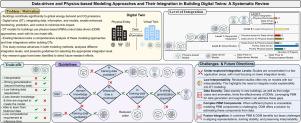数据驱动和基于物理的建模方法及其在构建数字孪生中的集成:系统回顾
IF 7.4
2区 工程技术
Q1 CONSTRUCTION & BUILDING TECHNOLOGY
引用次数: 0
摘要
作为建筑、工程和建筑行业更广泛的数字化转型的一部分,建筑行业对数字孪生技术的兴趣显著增长。建筑数字孪生是通过数据、信息和模型捕捉建筑静态和动态行为的虚拟复制品。数字孪生模型可以使用数据驱动或基于物理的方法开发,每种方法都有不同的优点和局限性。数据驱动的模型可以从数据中学习复杂的行为,并且可以很好地扩展,但它们需要大型数据集,并且通常缺乏可解释性。相比之下,基于物理的模型通过基本原理提供可解释性和概括性,但在计算上要求很高。因此,通过混合建模集成这两种方法可以大大受益于构建数字孪生。然而,文献缺乏对构建数字孪生的整合策略的全面分析。本研究通过回顾数据驱动和基于物理的建模的进展以及分析各种集成级别来解决这一差距。结果表明,大多数研究依赖于孤立的模型,独立使用任何一种方法,而没有利用它们的互补优势。有些采用顺序集成,其中一个模型通知另一个模型,但缺乏实时或迭代反馈。一些实现了耦合集成,包括模型之间的主动数据交换和协作。只有三项研究探索了融合整合,其中两种方法完全统一到一个模型中。在此基础上,提出了一种综合考虑数据可用性、可解释性、泛化性和领域知识等因素选择合适的集成级别的方法。最后,确定了关键的研究差距和未来的方向,以指导进一步的工作。本文章由计算机程序翻译,如有差异,请以英文原文为准。

Data-driven and physics-based modeling approaches and their integration in building digital twins: A systematic review
Interest in digital twin technology has grown significantly within the building sector as part of the broader digital transformation in the architecture, engineering, and construction industry. A building digital twin is a virtual replica that captures a building’s static and dynamic behavior through data, information, and models. Digital twin models can be developed using data-driven or physics-based approaches, each with distinct advantages and limitations. Data-driven models can learn complex behaviors from data and scale well, but they require large datasets and often lack interpretability. In contrast, physics-based models offer interpretability and generalizability through fundamental principles but can be computationally demanding. Consequently, building digital twins can benefit greatly from integrating both approaches through hybrid modeling. However, the literature lacks a comprehensive analysis of integration strategies within building digital twins. This study addresses that gap by reviewing advances in data-driven and physics-based modeling and analyzing various integration levels. The results show that most studies rely on siloed models, using either approach independently without leveraging their complementary strengths. Some adopted sequential integration, where one model informs the other but lacks real-time or iterative feedback. A few achieved coupled integration, involving active data exchange and collaboration between models. Only three studies explored fusion integration, where both approaches are fully unified into a single model. Based on this review, a method is proposed for selecting the appropriate level of integration, considering factors such as data availability, interpretability, generalizability, and domain knowledge. Finally, key research gaps and future directions are identified to guide further work.
求助全文
通过发布文献求助,成功后即可免费获取论文全文。
去求助
来源期刊

Journal of building engineering
Engineering-Civil and Structural Engineering
CiteScore
10.00
自引率
12.50%
发文量
1901
审稿时长
35 days
期刊介绍:
The Journal of Building Engineering is an interdisciplinary journal that covers all aspects of science and technology concerned with the whole life cycle of the built environment; from the design phase through to construction, operation, performance, maintenance and its deterioration.
 求助内容:
求助内容: 应助结果提醒方式:
应助结果提醒方式:


